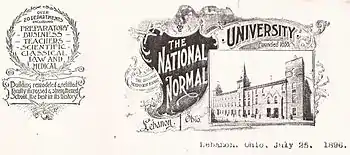Letterhead
A letterhead is the heading at the top of a sheet of letter paper (stationery). It consists of a name, address, logo or trademark, and sometimes a background pattern.
.jpg.webp)

Overview
Many companies and individuals prefer to create a letterhead template in a word processor or other software application. That generally includes the same information as pre-printed stationery but at lower cost. Letterhead can then be printed on stationery or plain paper, as needed, on a local output device or sent electronically.
Letterheads are generally printed by either the offset or letterpress methods. In most countries outside North America, company letterheads are printed A4 in size (210 mm x 297 mm).[1] In North America, the letter size is typically 8.5 x 11 inches (215 x 280 mm).
Although modern technology makes letterheads very easy to imitate, they continue to be used as evidence of authenticity.[2][3]
Gallery
 Letterhead (1896) for The National Normal University, Lebanon, Ohio, USA
Letterhead (1896) for The National Normal University, Lebanon, Ohio, USA Letterhead used by Infanta Elena of Spain, Duchess of Lugo
Letterhead used by Infanta Elena of Spain, Duchess of Lugo
See also
References
- "International Paper Sizes | Neenah Paper". www.neenahpaper.com. Retrieved 2017-02-26.
- Evidence and the Advocate: A Contextual Approach to Learning Evidence, Christopher W. Behan. LexisNexis, 2014. ISBN 0327175044, 9780327175049
- Federal Evidence Review, Editor's blog, 2009. http://federalevidence.com/blog/2009/august/documents-produced-discovery-were-“authentic-se”-during-summary-judgment-proceeding
Further reading
- Wheeler, Alina. Designing Brand Identity, 2012, pp. 146–147.